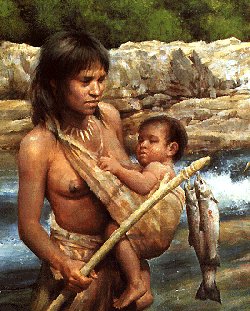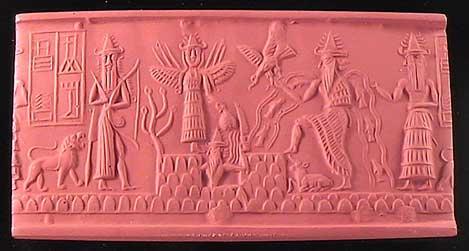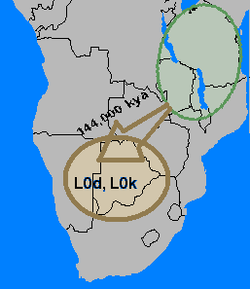

Who made the metropolis? Why?
It would seem that humans have always valued gold. It is even mentioned in the Bible, describing the Garden of Eden's rivers:
Genesis 2:11 -- The name of the first [river] is Pishon; it flows around the whole land of Havilah, where there is gold.
South Africa is known as the largest gold producing country of the world. The largest gold producing area of the world is Witwatersrand, the same region where the ancient metropolis is found. In fact nearby Johannesburg, one of the best known cities of South Africa, is also named "Egoli" which means the city of gold.
Is there evidence that mining took place, in southern Africa, during the Old Stone Age? Archaeological studies indicate that it indeed was so. Realizing that sites of abandoned ancient mines may indicate where gold could be found, South Africa's leading mining corporation, the Anglo-American Corporation, in the 1970s engaged archaeologists to look for such ancient mines. Published reports (Optima) detail the discovery in Swaziland and other sites in South Africa of extensive mining areas with shafts to depths of fifty feet. Stone objects and charcoal remains established dates of 35,000, 46,000, and 60,000 B.C. for these sites. The archaeologists and anthropologists who joined in dating the finds believed that mining technology was used in south- ern Africa "during much of the period subsequent to 100,000 B.C." In September 1988, a team of international physicists came to South Africa to verify the age of human habitats in Swaziland and Zululand. The most modern techniques indicated an age of 80,000 to 115,000 years. Regarding the most ancient gold mines of Monotapa in southern Zimbabwe, Zulu legends hold that they were worked by "artificially produced flesh and blood slaves created by the First People." These slaves, the Zulu legends recount, "went into battle with the Ape-Man" when "the great war star appeared in the sky" (see Indaba My Children, by the Zulu medicine man Credo Vusamazulu Mutwa). [Genesis Revisited] |
It seems highly probable that the ancient metropolis was established because of its proximity to the largest supply of gold on the planet. But why would ancient people work so hard to mine gold? You can't eat it. It's too soft to use for tool making. It isn't really useful for anything except ornaments and its physical beauty is on a par with other metals like copper or silver. Exactly why was gold so important to early homo sapiens?
To explore the answer we need to look at the period of history in question -- 160,000 to 200,000 years BCE -- and learn what was happening on planet Earth.
 Modern humans, homo sapiens, can trace our ancestry back through time to a point where our species evolved from other, more primitive, hominids. Scientists do not understand why this new type of human suddenly appeared, or how the change happened, but we can trace our genes back to a single female that is known as "Mitochondrial Eve". Mitochondrial Eve (mt-mrca) [Right: An artist's rendition] is the name given by researchers to the woman who is defined as the matrilineal most recent common ancestor (MRCA) for all currently living humans. Passed down from mother to offspring, all mitochondrial DNA (mtDNA) in every living person is derived from this one female individual. Mitochondrial Eve is the female counterpart of Y-chromosomal Adam, the patrilineal most recent common ancestor, although they lived at different times. Mitochondrial Eve is believed to have lived between 150,000 to 250,000 years BP, probably in East Africa, in the region of Tanzania and areas to the immediate south and west. Scientists speculate that she lived in a population of between perhaps 4000 to 5000 females capable of producing offspring at any given time. If other females had offspring with the evolutionary changes to their DNA we have no record of their survival. It appears that we are all descendants of this one human female.
[right] The region in Africa where one can find the greatest level of mitochondrial diversity (green) and the region anthropologists postulated the most ancient division in the human population began to occur (light brown). The ancient metropolis in located in this latter (brown) region which also corresponds to the estimated age when the genetic changes suddenly happened. Could this be a coincidence? |
Ancient Sumerian history describes the ancient metropolis and its inhabitants!


I'll be honest with you. This next part of the story is difficult to write. It's so shocking that the average person will not want to believe it. If you are like me, you'll want to do the research yourself, then allow some time for the facts to settle in your mind.
We are often made to believe that the Egyptians -- the Pharoahs and pyramids -- are where our known history begins. The oldest dynasties go back some 3200 years BP. That's a long time ago. But the Sumerian civilization, in what is now Iraq, is much older. What's more, we have translated many of their history tablets, written in cuneiform and earlier scripts so we know a lot about their history and legends.

The seal image [above] depicts the legend of the "Great Flood" which consumed mankind. Many Sumerian legends are strikingly similar to Genesis. Like Genesis, the Sumerian legend, Atrahasis, tells the story of the creation of modern humans -- not by a loving God -- but by beings from another planet who needed "slave workers" to help them mine gold on their extra-planetary expedition!
I warned that this is difficult to believe, but please keep reading.


 Mitochondrial Eve would have been roughly contemporary with humans whose fossils have been found in Ethiopia near the Omo River and at Hertho. Mitochondrial Eve lived significantly earlier than the out of Africa migration which might have occurred some 60,000 to 95,000 years ago.
Mitochondrial Eve would have been roughly contemporary with humans whose fossils have been found in Ethiopia near the Omo River and at Hertho. Mitochondrial Eve lived significantly earlier than the out of Africa migration which might have occurred some 60,000 to 95,000 years ago.